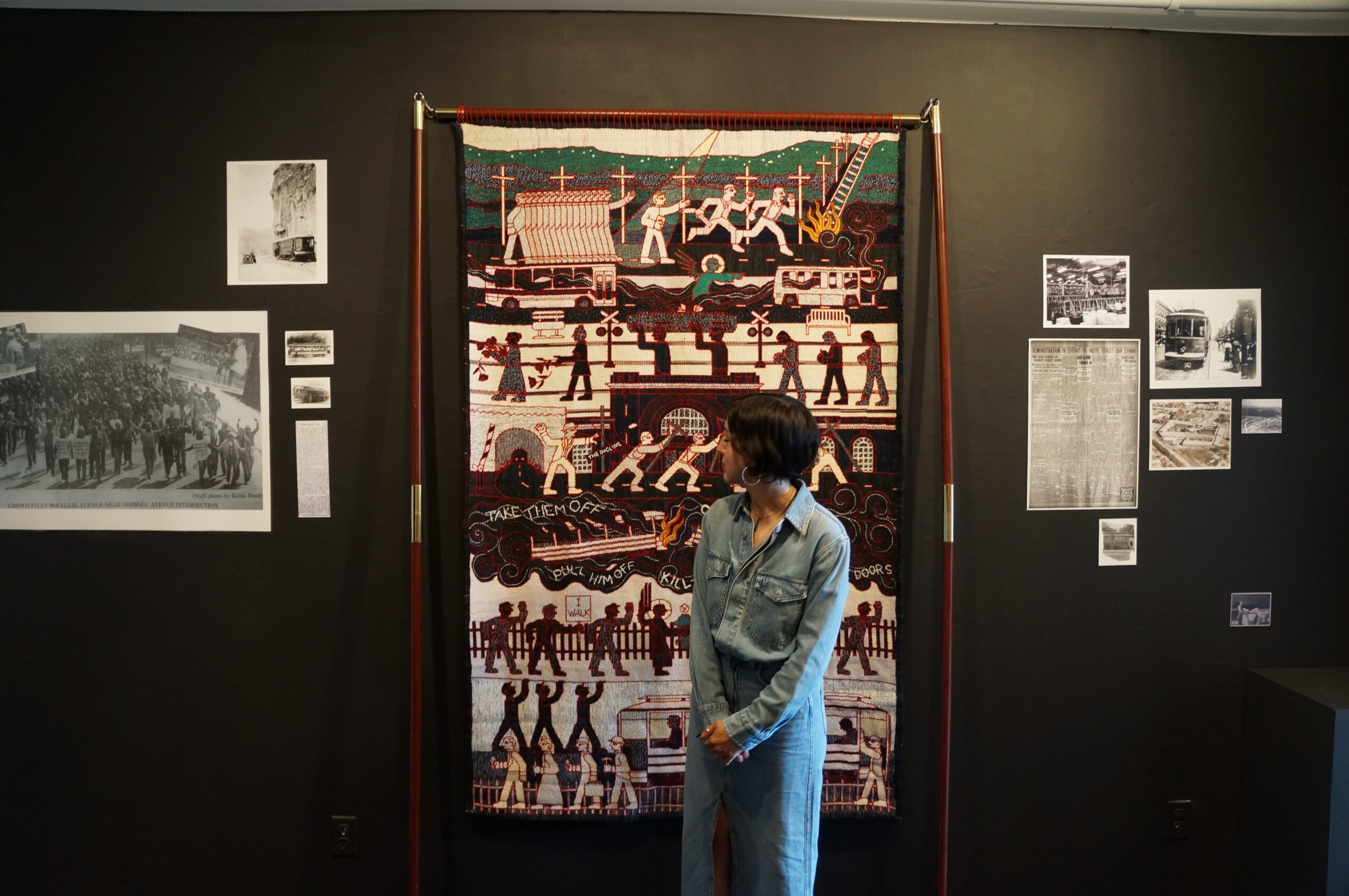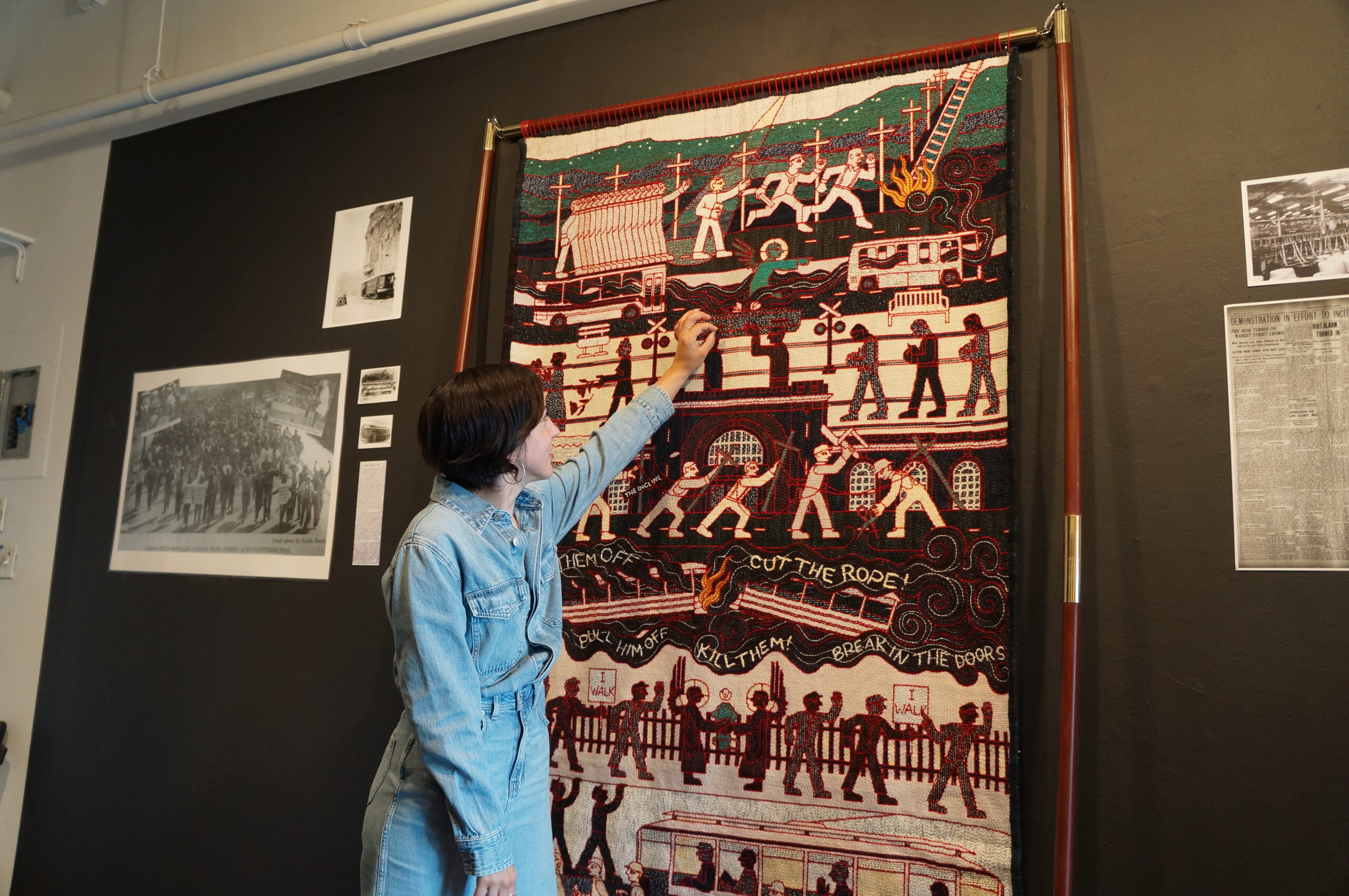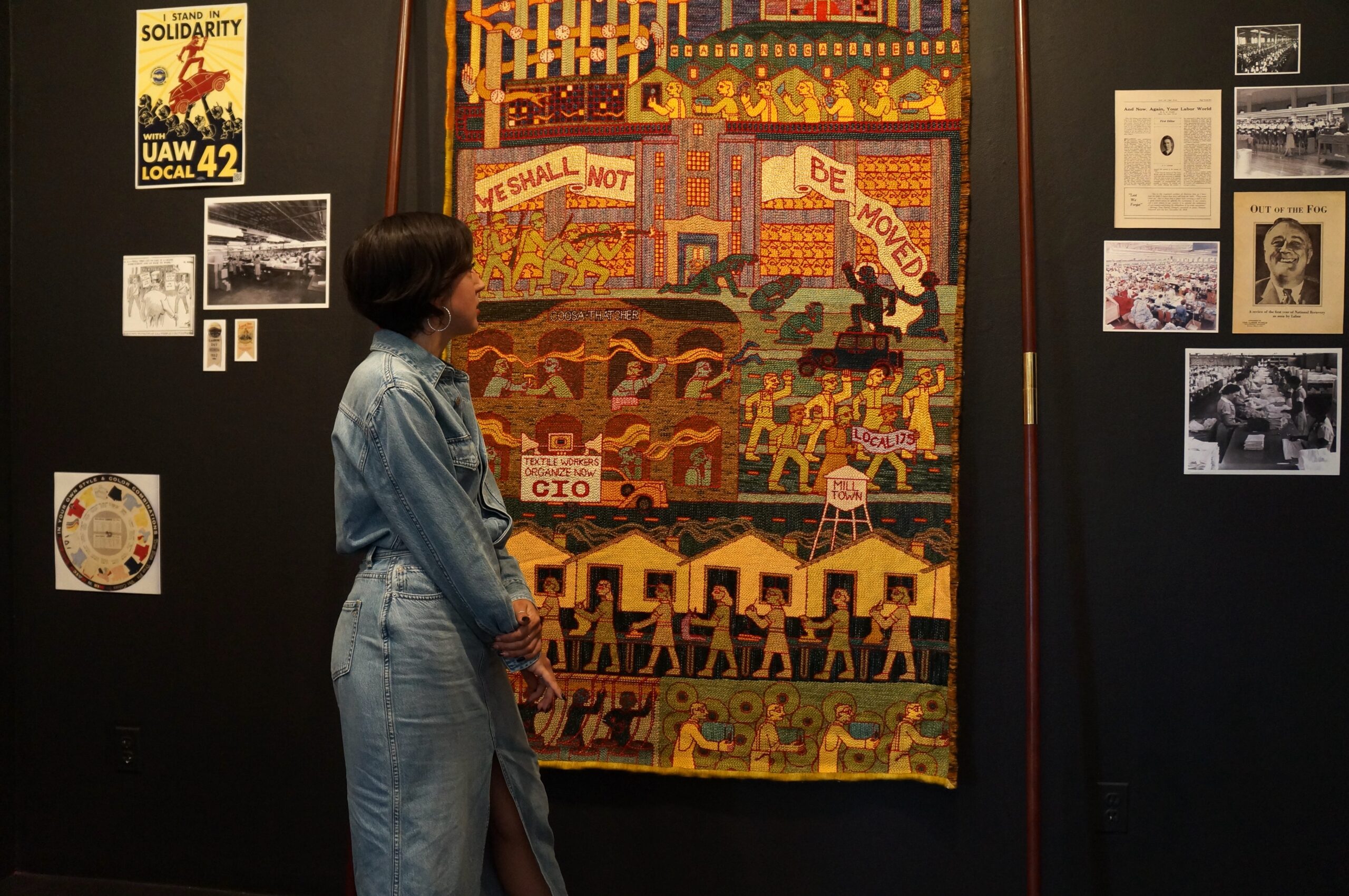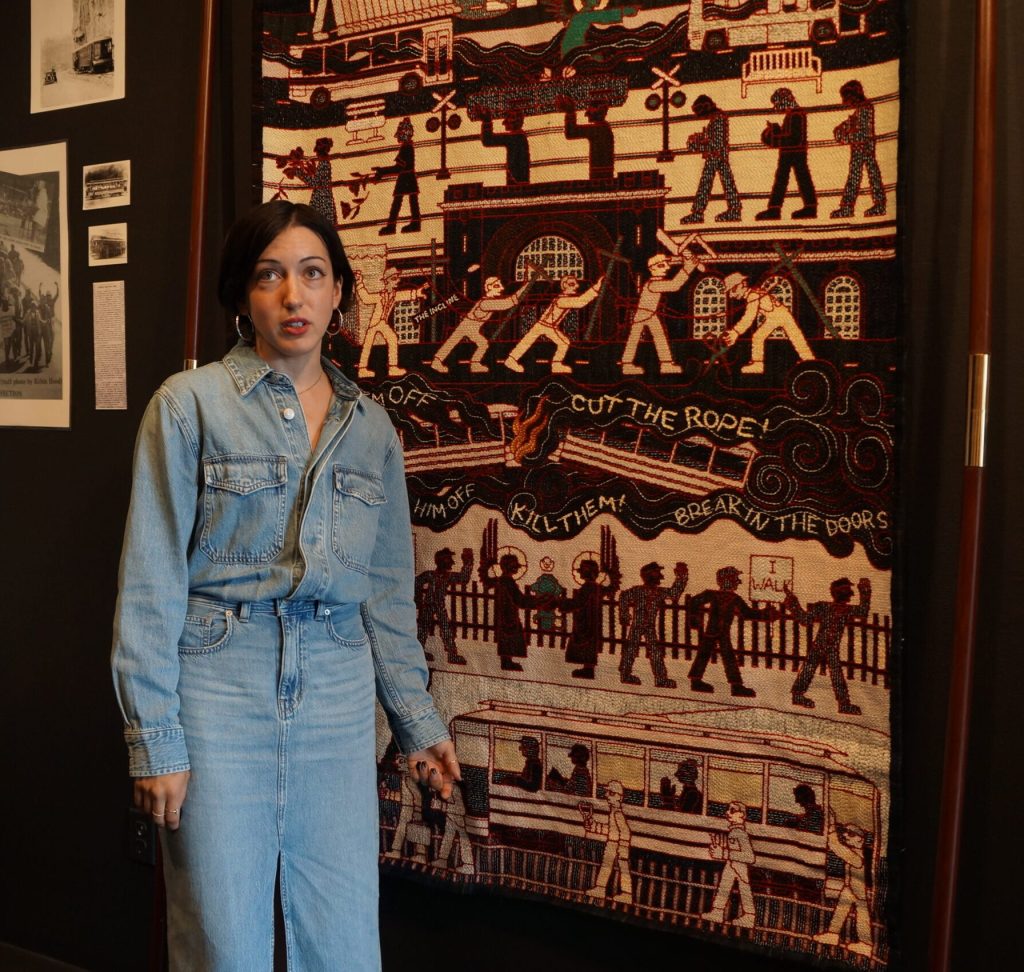
All photos courtesy of Douglas Corzine.
Tabitha Arnold doesn’t make quiet work. Her tapestries thrum with the noise of strikes, of sermons, of busy factory floors. Her latest series—now on display at Field Projects in New York City—resurrects Chattanooga’s buried labor history, from streetcar operators who walked off the job a century ago to modern auto workers fighting for a union contract. These aren’t just scenes—they’re stories, stitched together with righteous anger and archival receipts. Raised in church and trained in painting, Arnold has since swapped religion for revolution, oil and canvas for the punch needle and the loom. Her tangible, “labor-intensive” art is both personal and political, driven by her values and her own experience as a labor organizer. We sat down to talk just after Labor Day, as she was setting up the new exhibition.
———
DOUGLAS CORZINE: First of all, nice to meet you. Yesterday was Labor Day. How did you mark the occasion?
TABITHA ARNOLD: Well, I drove here because I tried to ship my work to New York and made a mistake with the address, so I ended up having to drive it up all by myself. But I stayed overnight in Wheeling, West Virginia, which was awesome, and then came here. I missed the Labor Day parade, which seemed really awesome. So I guess I labored.
CORZINE: What took you to Wheeling?
ARNOLD: One of my closest friends in Chattanooga is originally from Wheeling. I wanted to stop and see the Walter Reuther statue, and I had just heard they had this amazing organizing community. I saw this place called MoJo, which is a community arts center with a lot of free programming for the public. So I was just curious about what’s going on.
CORZINE: In addition to your work as an artist, you have also worked and organized in the service industry. How do you filter your own organizing experience into your art?
ARNOLD: It’s interesting. I feel like my tapestry work is not very autobiographical, really. I don’t really portray myself ever, but it is all rooted in my own experience. Being an organizer made me realize the amazing transformation people go through when they realize that they can be in a union and have power. So I don’t necessarily portray exactly what I went through, but I look for it in other labor struggles and I try to get to the spiritual and emotional heart of it.
CORZINE: You’ve talked before about the need for political artists to keep organizing and taking action beyond their art. I’m wondering how you do that now as a full-time artist.
ARNOLD: Yeah, it’s tough. Sometimes I feel like a more effective place for me to be in is community organizing because I keep getting opportunities to make artwork. But right now I’m the chair of my DSA [Democratic Socialists of America] chapter in Chattanooga, so it feels more like administrative organizing than the excitement of being part of a labor movement. There’s also a community solidarity project between people in Chattanooga and the UAW at Volkswagen because the new local won their union drive about a year ago, but they still have to negotiate a contract, which is one of the hardest parts. So I do some design work for their shirts, signs, and banners. I’ll do illustrations here and there, but it is a tough line to straddle. I miss labor organizing and being a direct part of it, but I hope what I’m doing is still helpful.
CORZINE: You have called your work “labor-intensive art.” I wonder if you can talk me through the actual physical labor that goes into making one of these pieces.
ARNOLD: I start with fabric stretched on a big set of canvas stretchers. Because I started as a painter, I was used to building canvases, but now I have embroidery backing linen, and it’s the size that the piece will eventually be. And then I’m embroidering with a punch needle, which is a faster technique than traditional embroidery. It still does take a really long time, and I will start at the very bottom of the piece and take it row by row. Generally, I don’t have a super cohesive image of what it’s going to look like at the end and these pieces take about 200 hours, give or take. So that ends up getting spread over a month or two. And during that time, I’m reading things and talking to people, so there’s a lot of room for them to change.

CORZINE: Does the flexibility of adjusting as you go feel like a departure from your painting background in some way?
ARNOLD: Yeah, I would just get paralyzed a lot with painting because every decision has a million different variants. I always found that so overwhelming. So when I got into tapestry weaving, it felt so different and just joyful. I felt like I could play around with it and I copied that process when I went into punch needle embroidery, which I got into because a representational image is more efficient to do with punch needle.
CORZINE: Do you feel like there’s a symbolism in the idea that you’re reading from the bottom up?
ARNOLD: I think it is part of the narrative because generally they will start with depictions of people having union meetings, and then they’ll escalate to what a lot of labor organizers would call the action thermometer. I see that happening in the work. You’re building with these very small actions that teach people at the workplace to trust each other and flex their power. And then the more you do, the bigger your actions can get. You can escalate to a strike or you can march on your boss and demand something to change, or you can get out and have a riot in the street. And generally, they’ll just erupt at the very top into something.
CORZINE: Can you just talk about how that applies to this particular work?
ARNOLD: So this piece is about a specific series of trolley car driver strikes and riots that happened in the 1910s in Chattanooga. It’s based on some newspaper coverage and photos from the library archive. In this piece, you can see people on the picket line joining this initial action that was prompted by an automatic fair collector. It’s a green object toward the bottom. It was demonstrating a lack of trust in the trolley drivers to be able to collect their own fares without stealing them. So it was about dignity and respect, which is what a lot of labor stuff is about. And then you have the “I Walk” campaign, where people walked miles and miles to go to work instead of public transit.

CORZINE: Chattanooga is also a particularly hilly city so it’s maybe not the easiest walk.
ARNOLD: Yeah, it’s mountainous enough that our last surviving train or trolley car is the incline. So you would have to take the incline up and down Lookout Mountain. So then it got to the riots because community members started taking it into their own hands at one point—attacking scab drivers, throwing furniture at them, and derailing the trolleys. Then, it goes up to a funeral. There was a really pivotal moment where a bystander got shot by a scab driver during an altercation in one of these riots and his funeral ended up being a big galvanizing moment for the union. The top, I would say, is where it gets spiritual and takes a little bit of a wider lens. I found it really interesting how much of that particular event was interwoven with spiritual leaders and spiritual language. There were moments where the community would gather to talk about the strike, and it would always be almost like, emceed by different preachers, and they would address the crowd using biblical language—they called it David and Goliath between the strikers and the company, and then they described the strikers as god’s children. They were employing a very emotionally charged language for the southerners, but also a language that helps people understand a moral struggle.
CORZINE: The title for this exhibition actually comes from a book about Southern preachers who were helping organize during the 30s and 40s. So it’s interesting that you talk about the spirituality of your work. Did you feel like you were carrying on their legacy when you named it that?
ARNOLD: Yes, I think. I mean, I found the book really interesting and inspiring. It’s about these two southern preachers who started as pretty typical clergy and then became radicalized by their congregation’s needs, leading them in union efforts. But the title itself, I really just wanted to steal because I think that it captured a lot of what I was also thinking about. I think about gospel as a really interesting device for the idea that you can form a union from being something that a lot of people gate-kept in the South, and the practice of union organizing being something that’s like teaching someone about what they can do and how much power they have. I’m really interested in how people in the South have appropriated Christianity and spirituality because I think we’re all used to seeing it appropriated by the right as an anti-worker kind of device. And it has made a lot of people, understandably, very bitter toward the way that Christianity exists in American culture. But the fact that it’s so hegemonic in the South is also something that people have been able to exploit toward a pro-union or socialist cause. Every time Shawn Fain came to town to address the Volkswagen workers, he would talk about having faith as small as a mustard seed and being able to move mountains. So it’s the same strategy and it works really well.
CORZINE: How does this version of the exhibit differ from what went up in Chattanooga in the winter? Is there anything new you’ve brought to it?
ARNOLD: Nothing new, it’s just a lot smaller. New York has a little less real estate than I had in Chattanooga so there’s several things omitted from this version, but I think it’s still really good.
CORZINE: I’m actually from Nashville, so I first heard of your work from friends back in Tennessee and I wonder, bringing this to New York, if you feel like there’s anything you want people viewing your work to understand or reconsider about the South?
ARNOLD: I think a lot of people who’ve never lived in the South might have some reactionary assumptions about it. I lived in Philadelphia for nine years and sometimes I would get frustrated feeling like I was being put on the defensive about the South. But I think I want to spin it a little bit differently. And one of the books I have on display in this exhibit is Hammer and Hoe by Robin D.G. Kelley, who is probably my favorite contemporary historian of the South, and he has described the South being this site of revolution in the United States. I mean, abolition of slavery was the biggest revolution we’ve had in this country and in the 1930s, we got about as close as you could to a real communist revolution. And a lot of that was led by working-class people in Alabama whose stories don’t get told in a lot of places outside of Hammer and Hoe, which everyone should read. So I think I want to emphasize that the reason the South is so reactionary is because they got really, really close at one point. And I think the work being done there is vital because right now it exists as an internal colony. It’s where companies go to get guaranteed lower wages and lower standards of workplace safety—
CORZINE: And Tennessee has been cutting deals with automakers like that for 45 years.
ARNOLD: Oh, absolutely. I mean, after the UAW made so many massive union victories in Detroit and around Michigan, a lot of these auto plants moved to the South and it became very, very difficult to organize because all these manufacturers have gotten to enjoy really low wages and they’ve had these politicians giving them tax breaks. Chattanooga is no exception. So I want people to know that that is a frontier that people in the South are fighting and their victory means something for everyone. The lowest-paid person in the country is going to set everybody back. So as long as someone non-union is doing this work in very dangerous working conditions, it’s dragging every single worker down.

CORZINE: You mentioned automation as sort of a common labor cause. And I just want to ask if you think that the tactile nature of your work and the labor-intensive quality feels, in any way, like a response to trends toward automation?
ARNOLD: I don’t think, for me personally, that my preference for craft is about automation. I wouldn’t say it’s a reaction. For me, the craft process is part of the work and it’s important to me that I do it all by hand and I don’t use a tufting gun or any kind of efficient technology beyond a punch needle because the craft is the work. I also think that this technique connects me to workers in an interesting way. The first one I made, the Volkswagen campaign, I brought that to a community solidarity meeting about a week before the Volkswagen union vote, so all these workers were there and they were seeing this piece celebrating them. And the first question they all would ask would be, “How long does it take?” So just describing hours of labor, that’s a language that makes sense to everyone who’s worked. That gave it so much meaning to them, that I put in that amount of time thinking about them and their struggle. Contemporary art can be impenetrable to people without a fine arts education, so it was really powerful to do something labor-intensive and then have that connection with working people.
CORZINE: What are you working on now?
ARNOLD: Well, I do want there to be a fourth one of these Chattanooga tapestries. I am a little unsure about the subject. My project partner—The People’s History of Chattanooga, which is a volunteer research project that looks at labor history—wants me to do one about the Knights of Labor, but we don’t have any pictures of it. So I’m a little up in the air. And eventually I am hoping to do a commission for the UAW directly, but that’s something that their union has to vote on. So we’ll let them decide.

